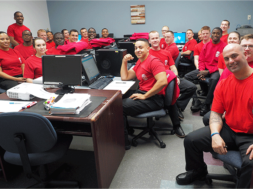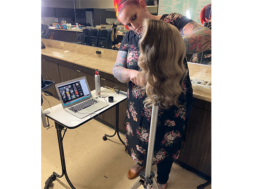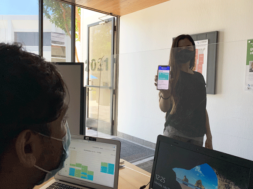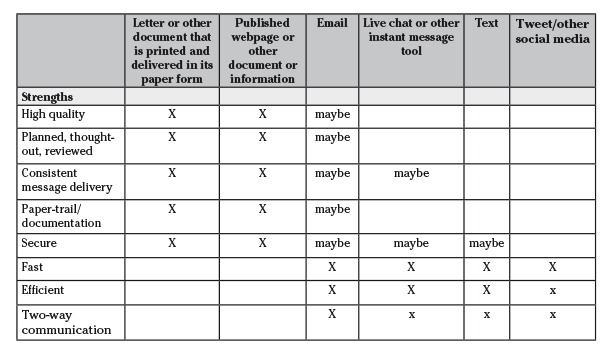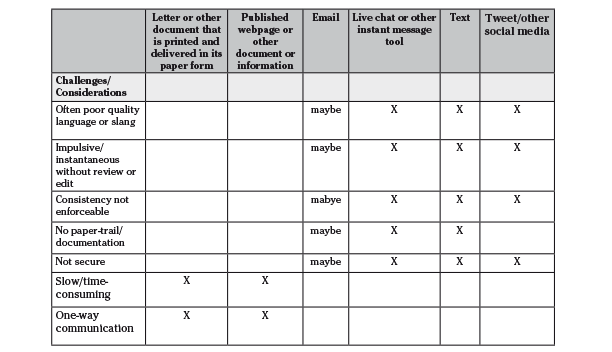
Enhancing Communication and Collaboration for Institutional Success
By Elizabeth Keifer Herron, VP – Solutions & Sales, Collegiate Admission and Retention Solutions
Communication defined – Google definition of communication
com•mu•ni•ca•tion
noun
1. the imparting or exchanging of information or news
2. means of connection between people or places, in particular
There are three primary forms of communication – verbal, written, and non-verbal/body language. Within each form of communication, there are numerous styles and methods, and each impacts the outcome of the message. Within our institutions, each type of relationship may also contribute to the form or style of communication utilized. This article will address each form of communication making a note of the strengths and challenges with each type, and provide suggestions to avoid certain pitfalls.
Verbal communication
We communicate verbally countless times each day; face-to-face, over the telephone, in small and large-group meetings/presentations, and through online or web-based meetings and conferences. The relationship between or among the parties speaking will drive the style or format for the verbal exchange.
Knowing your audience or having an understanding of the way in which they prefer to receive information can greatly improve the success of the dialogue, as can the ability to have two-way communication, rather than one-way communication.
Pros and cons of verbal communication
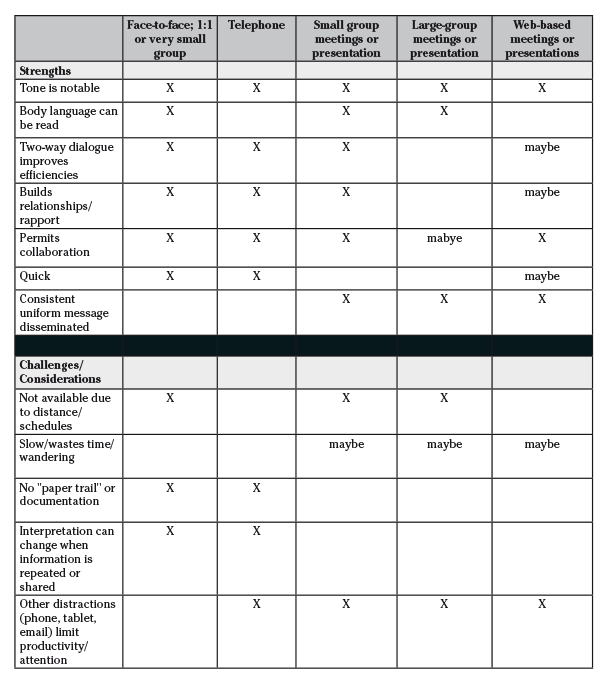
We may have the opportunity to choose the best way to deliver information for maximum success, but are often thrown into situations where urgency overrules choosing the most advantageous approach. Knowing the advantages and limitations of each is critical to getting the most out of your verbal exchanges. Strategies to overcome some of the aforementioned challenges include:
- Utilize an agenda or brief list of points to keep small and large-group meetings on track;
- Request participants turn off other electronic devices to focus exclusively on the conversation/meeting;
- Listen carefully when soliciting input or asking questions, and summarize what you have heard;
- Allow time for socializing/rapport building at the beginning of a meeting or conversation, increasing the likelihood of the balance staying on track; and
- Utilize language and pace to engage the majority of your participants.
Listening is an overlooked but necessary life skill. Have you ever played “whisper down the lane?” Try it sometime with your staff or a small workgroup or team. Have your team stand in line, with all parties facing the back of the person in front of them. Go to the first person facing you and read your accreditor’s mission statement (or some other relevant small paragraph). Ask them to turn around and repeat it to the next person, and so on. Have the final person say what they heard, and then re-read the actual text. Much of the text will be “lost in translation.” Why? We practice all sorts of skills in our workplaces, but engaged, active listening is not often one of them. What can we do to improve listening in our organization?
- Eliminate distractions;
- Utilize pace and tone to maximize comprehension;
- Repeat what you have heard to validate your understanding of what was said; and
- Understand your audience and modify delivery/content or style appropriately.
Non-verbal communication
What assists people to communicate across language barriers? Are there times when what you say is less important than how you say it? How do our facial expressions or stance affect what we say? Consider the statistics presented by Albert Mehrabian in his communication model in 1981:
“In a spoken message, 55 percent of the meaning is translated non-verbally, 38 percent is indicated by the tone of voice, while only 7 percent is conveyed by the words used (Mehrabian, 1981).” https://www.toolshero.com/communication-skills/communication-model-mehrabian/
When an angry customer or dissatisfied employee raises their voice and shakes their fist, all the while saying “I am not upset,” the words have little meaning. Similarly, if you have a warm and open stance and a smile on your face that extends to your eyes, you can gain trust and engagement even if the message may be less than positive.
To emphasize the impact our non-verbal cues have on our message, hand out slips of paper with emotions to every member of a small workgroup (anxiety, excitement, anger, frustration, contentment and others). Ask each person to think about the emotion that they have been given and to use body language and facial expressions to convey their emotion while saying the following: “Our annual budget meeting is less than two weeks away, and we have a lot to discuss.” Ask each person to identify the emotion being conveyed, and discuss the body language and facial expressions that helped guide them to identify the emotion including:
- Eye contact and movement;
- Expression with the mouth;
- Position or use of the hands and arms;
- Set of the head and shoulders (tensed, relaxed); and
- Overall body position (leaning forward, held back, moving or steady).
Written communication
The percentage of time spent each day between oral and written communication has been shifting toward written, in large part due to the prevalence of smartphones in every pocket. In the past 10 years, we have seen a tremendous shift from using telephones to speak, to using them to text, tweet, email, or browse the internet. Even in our workplace, many people turn to email, instant message forums, or “live chat,” rather than picking up the telephone to speak to a colleague. What has been lost and what has been gained in this transition?
Pros and cons of written communication
What can you do to protect your institution from these pitfalls, while embracing the shift to less traditional forms of communication?
- Establish policies regarding use of personal devices for business use, including access to the communication history;
- If live chat or a similar tool is deployed, use one that documents the exchange;
- Deploy protocols regarding email communication to ensure consistency of message, brand and adherence to policies;
- Train team members on the treatment of personally identifiable information or other information that is “protected;”
- Caution team members on the permanence of their electronic “footprint” and require corporate review of any institutionally-related messages; and
- Recognize the need to adapt.
Styles of communication
There are numerous “personality” tests or assessments used by organizations to help people understand each other and strengthen working relationships. People have innate preferences regarding how they communicate, process information, participate in groups, and address risk. Websites to some of the more common personality assessments are included at the end of this article.
How we communicate is largely driven by who we are and our preferences. Sadly, the people with whom we communicate may not share the same preferences or style, making collaboration challenging. Try this activity to help your team members identify their preferences and appreciate those of the other team members.
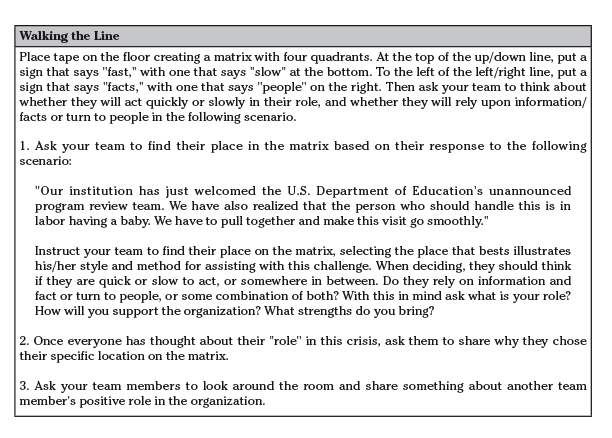
Using a variety of the personality indicators, we can categorize four basic styles of communication as follows:
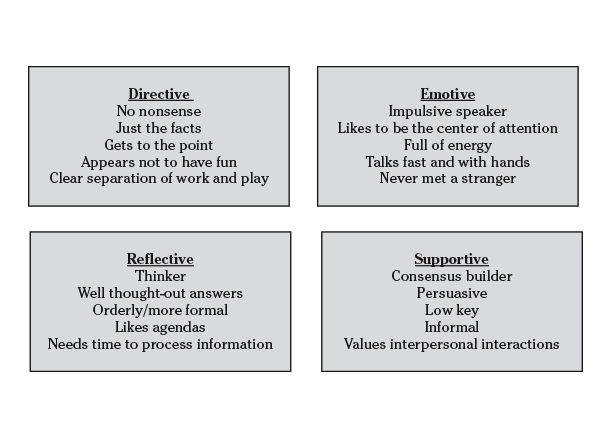
In order to maximize the effectiveness of our institutions, we must appreciate the different styles and strengths of our team members and take advantage of their human capital as a resource. The “Walking the Line” activity creates positive dialogue around our differences and the way each member contributes to the organization.
The regulatory burdens facing higher education have lessened recently, but the administrative burden to meet state, federal, and accreditor requirements have not been eliminated. We ask our team members to wear many different “hats” and to step in when there is a crisis. Taking time to discuss styles of communication and ways to maximize the effectiveness of our relationships will improve individual and overall team performance.
References for personality type assessments
- http://www.myersbriggs.org/my-mbti-personality-type/mbti-basics/the-16-mbti-types.htm?bhcp=1
- http://www.discprofiles.com/blog/2012/10/examples-of-12-disc-styles/
- https://psychcentral.com/personality-test/start.php
- https://www.123test.com/jung-personality-test/
ELIZABETH KEIFER HERRON, a founding partner of PEAC Student Loan Assistance, is currently a member of the executive management team of CARS. Elizabeth provides client services, community outreach, and is the chief compliance specialist for the family of companies. Serving on numerous committees for higher education associations, she presents at many workshops and conferences; her presence in Washington, D.C. enables her to access up-to-the-minute information on a variety of legislative and regulatory issues affecting the industry. Prior to founding PEAC in 1992, Elizabeth was the chief lobbyist for the Career College Association (now CECU). She received her BA with honors in Political Science and Economics from Douglass College of Rutgers University, and resides in Washington, D.C. with her husband and two boys.
Contact Information: Elizabeth Keifer Herron // Vice President – Solutions & Sales // Collegiate Admission and Retention Solutions (CARS) // 202-558-2337 // ekherron@collegiatersvp.com // www.collegiatersvp.com // https://www.linkedin.com/in/elizabeth-herron-446595/




